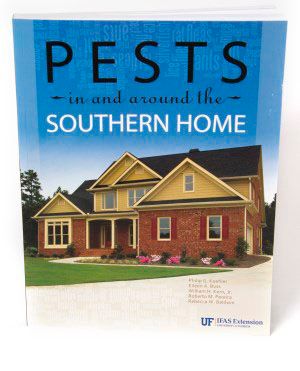
There are a little over 40,000 species of spider in the world, about 1,200 of which may be found in the United States. They live everywhere, even inside homes and buildings. In fact, some spider species have become so adapted to conditions within human dwellings that they can no longer survive outside. In their natural environment (including human dwellings) spiders are important arthropod predators and serve a vital function in controlling insect populations. Due to spiders' reclusive habits, most people are unaware of how many spiders actually exist in a given environment at any time. A single acre of grassy field, for example, can contain up to two million individual spiders.
Although all spider species possess venom-injecting fangs, only a tiny minority are able to pierce human skin and inject venom into the tissue. Among this minority, only a few pose any threat to human health. The brown recluse and the widow spiders are two well-known and highly venomous examples.
Biology and Description
Spiders are arachnids, related to mites, ticks, and scorpions, which differ from insects in their body morphology in three important ways:
- Spiders have only two body regions (cephalothorax and abdomen) rather than three.
- Spiders have eight walking limbs rather than six.
- Spiders never develop wings, unlike many insects.
Spiders are predators, feeding primarily on insects and other arthropods. Although the exact details of the feeding strategies for spiders vary, all spiders predigest their prey by injecting or covering the prey item with digestive fluids, after which they consume the liquefied meal. Spiders can survive for long periods of time without feeding. Some spiders have been kept alive for over two years without feeding.
Because spiders feed entirely on living insects or other animals, they are highly adapted to capture and subdue living prey. Some, such as jumping spiders or wolf spiders (Figure 2), actively search for or stalk their prey. Others, such as the trap-door spiders, hide and wait for hapless arthropods to pass too closely. Perhaps the best known spiders are called orb weavers, who build ornate webs that trap flying insects.
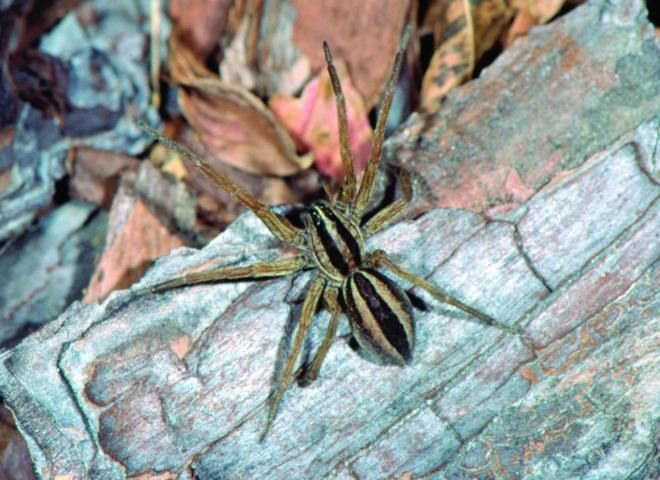
Most web-spinning spiders build and abandon several webs per year. The webs are produced by glands on the spider's abdomen. The silk is a liquid protein that is shaped into various configurations by the spider's appendages as it is excreted. Silk is used to construct webs, safety lines, shelters, and egg sacs. A special type of silk is sometimes used as a parachute by spiderlings for dispersal or adults to travel long distances.
Spiders reproduce by laying eggs in a silken egg sac (Figure 3). The egg sac is either carried around by the female or hidden in the web. Egg sacs of large spiders may contain several hundred eggs. The eggs hatch in about two to three weeks after they are deposited. Most young spiders mature to adults in about one year. Male and female spiders live separately and only come together to mate. Males are usually smaller and color-marked differently from females.
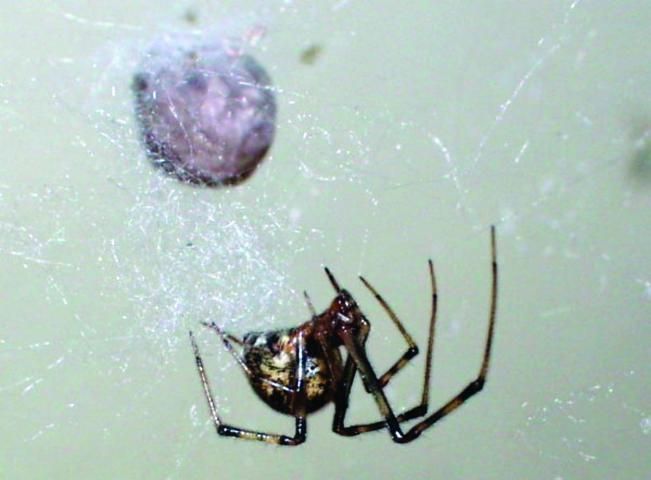
Almost all spiders are harmless to humans, and most species do not attempt to bite unless they are provoked. Spiders usually remain hidden and do not seek out and bite humans. Most spiders cannot penetrate the skin of a human with their fangs. All spiders produce venom, but only a few can pierce human skin, and even fewer are considered dangerous to humans.
Spiders are of interest since some invade homes, others are considered venomous, and some larger species are raised as pets.
House Spiders
Several species of spider enter houses and become nuisances to the homeowner. Many people simply dislike spiders and cannot tolerate their presence. When numerous, spiders are annoying because they construct webs, which collect dust and other detritus, resulting in cobwebs. However, most spiders are considered beneficial because they feed on insect pests and other spiders.
Newly hatched spiders are tiny and easily enter homes through screens or around loose-fitting doors and windows. Careful screening will keep larger spiders out of homes. If insects that serve as spider prey are not plentiful in a home, spiders are less likely to infest a home.
Nonchemical Control of Spiders
Nonchemical control of spiders is usually quite effective in reducing spider populations. Outside lights should not be left on at night. Large numbers of flying insects attracted to lights cause spiders to be numerous around garages and under eaves. Trash, lumber piles, bricks, weeds, and outside structures are good breeding places for spiders and should be cleaned up regularly. Inside the home, spider webs should be brushed down. The egg sacs should be destroyed to prevent hundreds of young spiders from emerging. A vacuum cleaner fitted with appropriate attachments may be used to clean walls, and the collected debris should be destroyed or removed from the house.
Chemical Control of Spiders
Chemical control of spiders outdoors is difficult because web-spinning spiders do not tend to contact treated surfaces. Space sprays containing pyrethrins or pyrethroids are effective in killing spiders, but have little residual activity. These sprays may be applied when spiders are noticed. When spraying enclosed areas, care should be taken so spiders agitated by the spray do not drop onto the person doing the spraying. Repeat the treatment in four weeks to kill young spiders that hatch from egg sacs.
Dust formulations can be used in crawlspaces, attics, and utility areas to provide long-term protection. The insecticidal dusts tend to cling to the spider webs for long periods of time. When spiders chew their webs to recycle the silk they consume the toxicant and die.
Venomous Spiders
It is important to save any biting spider so it can be identified later. Without a specimen for positive identification, spider bites are often improperly treated, and in many cases other medical conditions are mistaken for spider bites. Most spider bites are not dangerous, but medical care and advice should be sought in any case of a suspected spider bite.
Widow Spiders
Four species of widow spiders occur: the southern black widow, the northern black widow, the red widow, and the brown widow (Figure 4). All these species are rather large spiders, about 1.5-inches (3.8-cm) long with the legs extended. To catch prey, widow spiders weave a strong web of irregular strands. The web is often found in rock formations or wood piles. Strands of black widow web were used to form the crosshairs of gun sights during World War II due to the strength and durability of the silk material.
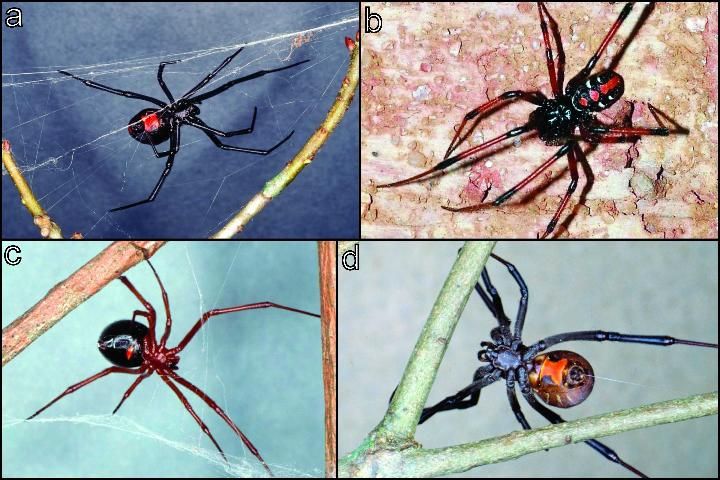
The southern black widow and the northern black widow are a shiny jet-black. The southern black widow has a red hourglass marking on the underside of the abdomen and another red spot at the tip end of the abdomen. The northern black widow has a row of red spots located in the middle of its back and two reddish triangles resembling an hourglass on the underside of the abdomen. The red widow spider has a reddish orange head, thorax, and legs, and a black abdomen. The abdomen may have a dorsal row of red spots with a yellow border. The red widow lacks a complete hourglass under the abdomen but may have one or two red spots. The brown widow spider varies in color from gray to light brown or black. The abdomen has variable markings of black, white, red and yellow. On the underside of the abdomen, it has an orange or yellowish-red hourglass marking.
The life cycles of the widow spiders are all similar. The female lays approximately 250 eggs in an egg sac, which is about 1/2 to 5/8 inch (1.3 to 1.6 cm) in diameter. Female widows remain with the egg sac and guard it aggressively from potential predators. The eggs hatch in 20 days and the young spiders (called post-embryos) remain in the egg sac from about four days to one month. The young spiders then molt to the second stage and begin feeding. As the young spiders grow, they construct loosely woven webs and capture progressively larger prey. Male spiders molt three to six times before maturing. The females molt six to eight times and occasionally eat the males after mating. In Florida, all the widows except the northern black widow breed year-round.
- The southern black widow is usually found outdoors in protected places such as in hollows of stumps, discarded building materials, rodent burrows, storm sewers, and under park benches and tables. Around houses, the southern black widow is found in garages, storage sheds, crawl spaces under buildings, furniture, ventilators, and rainspouts.
- The northern black widow is mainly found in forests. It spins irregular, loosely woven webs 3 to 20 feet (0.9 to 6 m) above the ground.
- The red widow spider makes its web off the ground in palmetto habitats and has only been found in sand-pine scrub associations. The web retreat is characterized by the rolled palmetto frond, and the web is spread over the fronds.
- The brown widow is most common on, but not restricted to, buildings. They are also found on bridges and fences. The egg sac looks like an old naval mine or a sandspur seed (Figure 5).
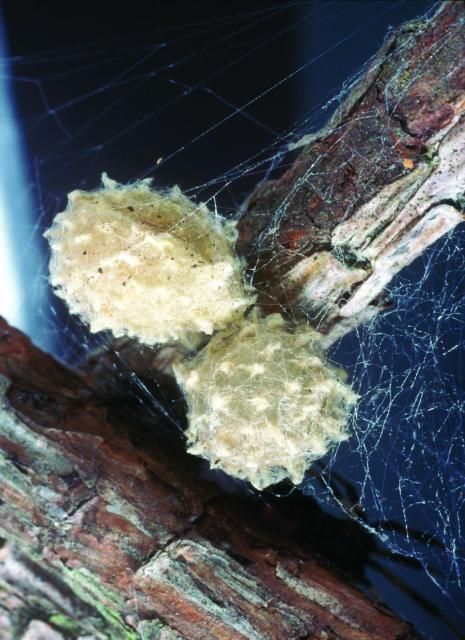
The spiders are extremely timid; the only bites reported have resulted from a spider being accidentally trapped against the victim's body. They reproduce rapidly, and one female can produce up to 18 egg sacs. Once encountered, a spider is indicative of a widespread population that is extremely difficult, if not impossible given available control methods, to eradicate.
Like most spiders, the widow spiders are shy and will not bite unless aggravated. All four species have strong, neurotoxic venom based on a protein called latrotoxin, which is common to all widow species. The southern black widow is involved in most venomous spider-bite cases in Florida. The bite of the black widow is not always felt, but usually feels like a pinprick. The initial pain disappears rapidly, leaving a local swelling where two tiny, red spots appear. Muscular cramps in the shoulder, thigh, and back usually begin within 15 minutes to 3 hours. In severe cases, pain spreads to the abdomen, the blood pressure rises, and there is nausea, profuse sweating, and difficulty in breathing. Death may result from the venom, depending on the victim's physical condition, age, and location of the bite. However, death seldom occurs if a physician is consulted and treatment is prompt.
If you suspect that a widow spider has bitten you, capture the specimen for identification and immediately consult a physician. For additional information, your doctor may wish to contact your local poison control center.
Brown Recluse
The brown recluse spider (Figure 6) is not an aggressive biting spider, but physicians have diagnosed its bites. Despite these diagnoses, it has been estimated that up to 80% of suspected brown recluse bites are actually misdiagnosed cases of Staphylococcus infection. Unlike the widow spiders, the brown recluse possesses venom based on a protein called Loxosceles toxin, which directly affects contacted tissues rather than the nervous system. The venom can cause tissue necrosis similar to that observed with many infectious bacteria. The absence of brown recluse specimens thought to be responsible for the "bites" makes it impossible to definitively determine the prevalence of the species.
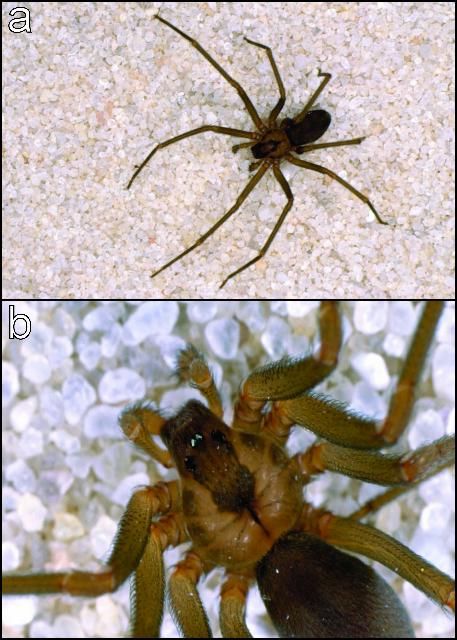
The brown recluse spider is recognized by having a dark violin-shaped mark located behind the eyes. There are three pairs of eyes on this species, while most spiders possess four pairs. The brown recluse is a medium-sized spider about 1/4 to 1/2 inch (0.6 to 1.3 cm) in length.
The brown recluse spider's natural habitat is along the Mississippi River valley, especially in northwestern Arkansas and southern Missouri. Because it can live in old boxes and furniture, it is easily transported by humans.
The brown recluse spider is a shy species that bites humans when trapped in clothing or rolled onto when people sleep in bed. Persons bitten by the brown recluse usually do not feel pain for two to three hours, although a sensitive person may feel pain immediately. A blister arises around the area of the bite. The local pain becomes intense, with the wound sloughing tissue often down to the bone. Healing takes place slowly and may take six to eight weeks. If the bite of a brown recluse spider is suspected, collect the spider and consult a physician immediately.
Tarantulas
The term "tarantula" refers to about 300 species of spider, some of which can weigh 2 to 3 ounces (57 to 85 g) and have a 10-inch (25-cm) leg span. Tarantulas (Figure 7) do not occur naturally in the southeastern United States; however, some people keep tarantulas as pets. At least one species of the genus Avicularia can be found in southern Florida, although it is not known if these sightings represent escaped specimens from captive populations or spiders imported accidentally in banana shipments. Most tarantulas commonly seen as pets are placid by nature, and few if any possess a strongly venomous bite. Some tarantulas, especially from old-world genera such as the Haplopelma spp., are extremely fast and aggressive and should be kept only by experienced hobbyists. Tarantulas rely on their size to overwhelm prey and do not utilize particularly potent venom. However, the size of their fangs can lead to painful bites solely from mechanical tissue damage.
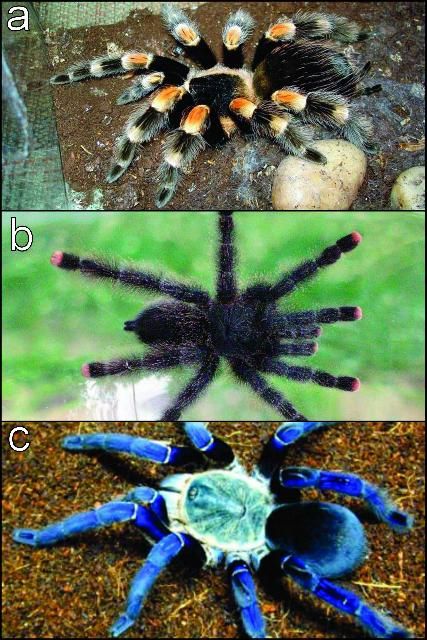
Credit: Wikipedia and tarantulaguide.com
Tarantula species native to the Americas have a dense covering of stinging hairs—called urticating hairs—on the abdomen to protect them from enemies. These hairs can cause skin and eye irritation for humans and may also provoke more severe allergic reactions in sensitive individuals. Over time, stressed tarantulas will develop a bald spot on their abdomen from repeated shedding of urticating hairs, which will be regenerated at the next molt. Tarantula species native to African and Asian countries lack this covering of urticating hairs and tend to rely on defensive displays or aggressive behavior for defense.
Tarantulas usually live in burrows in the ground, although numerous arboreal species also exist. Some species construct their own burrows and others take advantage of existing burrows, such as those built by rodents. In either case, the tunnels are lined with silk and form a webbed rim at the entrance which conceals it. When tarantulas are molting or otherwise do not wish to be disturbed, they may seal over the entrance completely with silk. The females deposit 500 to 1,000 eggs in a silken egg sac and guard it for six to seven weeks. The young spiders remain in the burrow for some time after hatching and then disperse by crawling in all directions. With the exception of a single South American genus, tarantulas are highly territorial and often cannibalistic.
Tarantulas may live for many years. Females of tropical species can require up to 10 years to mature to adulthood. Females kept in captivity have been known to live more than 25 years, and many desert species can survive for years without food. Females continue to molt after reaching maturity and, therefore, are able to regenerate lost legs and repair other injuries. Males often do not eat after reaching maturity and live for only one year or less.
A tarantula can be kept as a house pet. A terrarium (a dry aquarium) with an appropriate substrate can house a single specimen, but a quality tarantula-keeping manual should be consulted prior to purchasing a specimen, as many species have widely differed environmental requirements.